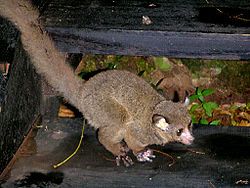| Otolemur [1] | |
|---|---|
 | |
| Brown greater galago (O. crassicaudatus) | |
| Scientific classification | |
| Kingdom: | Animalia |
| Phylum: | Chordata |
| Class: | Mammalia |
| Order: | Primates |
| Suborder: | Strepsirrhini |
| Family: | Galagidae |
| Genus: | Otolemur Coquerel, 1859 |
| Type species | |
| Otolemur agyisymbanus | |
| Species | |
Otolemur crassicaudatus Contents | |

The greater galagos [1] or thick-tailed bushbabies are three species of strepsirrhine primates. They are classified in the genus Otolemur in the family Galagidae.





